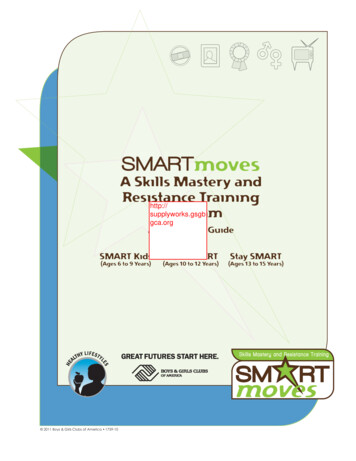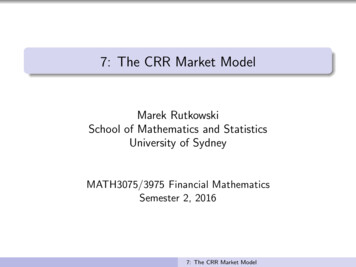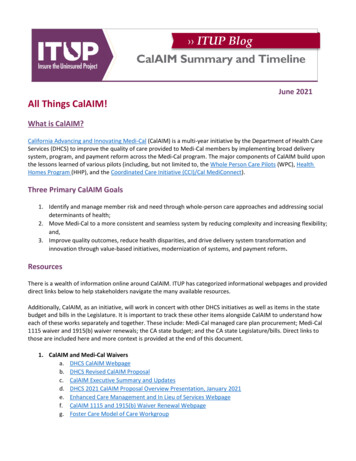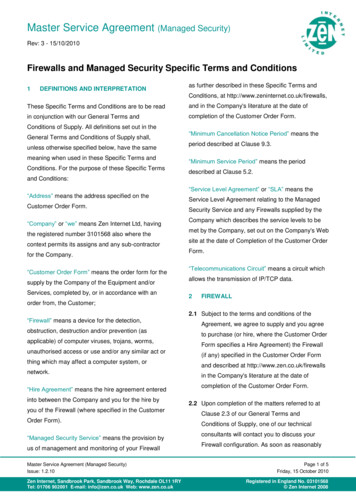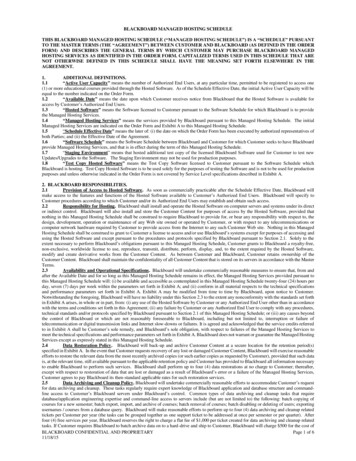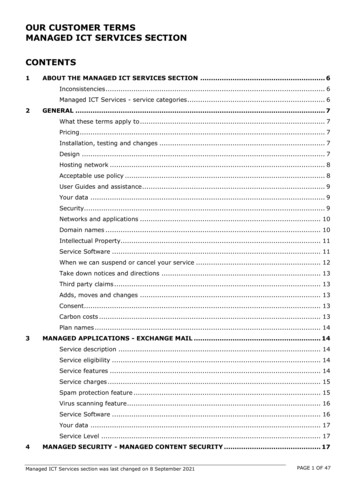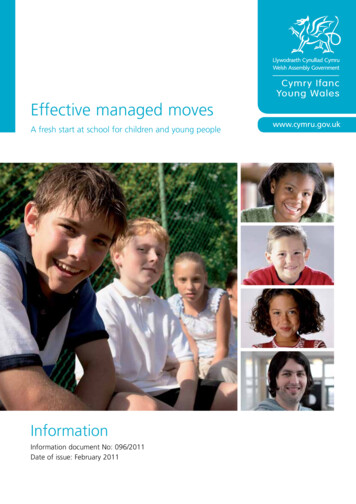
Transcription
Effective managed movesA fresh start at school for children and young peopleInformationInformation document No: 096/2011Date of issue: February 2011
Effective managed movesAudienceLocal authority officials dealing with inclusion and supportfor pupils.OverviewThis document provides best practice information to assist localauthorities to establish and implement effective protocols formanaged moves.ActionrequiredNone – for information.FurtherinformationEnquiries about this guidance should be directed to:Pupil Engagement TeamDepartment for Children, Education, Lifelong Learning and SkillsWelsh Assembly GovernmentCathays ParkCardiffCF10 3NQTel: 029 2082 1556Fax: 029 2080 1051e-mail: PETshare@wales.gsi.gov.ukAdditionalcopiesThis document can be accessed from the Welsh AssemblyGovernment website at sNational Behaviour and Attendance Review (NBAR) Report (2008)Behaving and Attending: Action Plan Responding to the NationalBehaviour and Attendance Review (2009)Inclusion and Pupil Support National Assembly for Wales Circular No:47/2006 (2006)Exclusions from Schools and Pupil Referral Units National Assemblyfor Wales Circular No: 1/2004 (2004)ISBN 978 0 7504 5853 5 Crown copyright 2011WAG10-10724F5121011
ContentsIntroduction2Section 1: Best practice information1.1What is a managed move?1.2Pupils who might benefit from a managed move1.3Points to consider1.4Setting up processes for a managed move: roles and responsibilities1.4.1Key players1.4.2Step-by-step processes1.5Managed moves: unacceptable school practices1.6Accepting or declining a managed move33345561616Section 2: Exemplar materialsExemplar 1: Managed moves – information for parents/carersExemplar 2: Invitation to managed move meeting – draft letter to parents/carersExemplar 3: Managed move agreement form (MM1)Exemplar 4: Managed move outcome form (MM2)1819212224Appendix: United Nations Convention on the Rights of the Child26
IntroductionThe Welsh Assembly Government recommends the consideration of managedmoves to provide pupils with the opportunity to make a fresh start in a new school.This practice can also reduce the need for permanent exclusions and minimise thenegative outcomes associated with them.To maximise the likelihood of success, it is essential that managed moves areundertaken with the full consent and cooperation of both schools, parents and pupilsand that all are made fully aware of the processes to follow. All those involved mustalso act in accordance with the School Admissions Code, and have regard to anyprotocols or guidance on this matter issued by the local admissions forum.The National Assembly for Wales Circular 47/2006 – Inclusion and Pupil Supportreferred to the use of managed moves as one of the early intervention strategies thatcan be considered to help pupils in the management of their behaviour andattendance at school.In response to recommendations made in the National Behaviour and AttendanceReview (NBAR) 1 , the Welsh Assembly Government committed to producing a bestpractice information document to assist schools to manage moves effectively.It is in this context that this document was produced in collaboration withWelsh local authorities.The document is set out in 2 brief sections:Section 1: Explains when it is appropriate to consider a managed move for a pupiland describes processes, roles and responsibilities to manage thetransfer and the integration process effectively.Section 2: Provides exemplar materials that can be modified as necessary.1Welsh Assembly Government (2009). Behaving and Attending: Action Plan Responding to theNational Behaviour and Attendance Review.2
Section 1: Best practice information1.1What is a managed move?A managed move is a carefully planned transfer of a pupil from one school intoanother.It enables a child or young person to move on to a new placement or programme ina way which is acceptable to all appropriate parties, especially the pupil. Theprocess is designed to help the pupil move forward and make a fresh start. The bestinterest of the child, in line with the United Nations Convention on the Rights of theChild (UNCRC) and the seven core aims in Children and Young People: Rights toAction, needs to be at the core of any managed move. A description of theUNCRC articles that are of particular relevance is given in Appendix 1.Where it is in the best interest of the pupil concerned, a managed move can be usedas a strategy to support the pupil and/or prevent a permanent exclusion.Evidence suggests that for a managed move to be successful, the full engagementof the pupil, parents/carers and the schools need to be fully considered and transportissues need to be addressed.1.2Pupils who might benefit from a managed moveA managed move is a strategy that is already being implemented for the followingpupils: pupils who are at risk of permanent exclusion but who might succeed in anew environment; pupils with emotional and behavioural difficulties who have received avariety of supportive strategies in their school with limited success; and pupils who find that attendance at their current school is negativelyaffecting their emotional welfare.Managed moves have to be considered when there is a genuine belief that a freshstart would be beneficial for the pupil. Prior to considering a managed move it isessential to establish the core reasons for the problems being experienced and/orthe behaviours being displayed by the pupil.For instance, moving a pupil with behavioural issues (e.g. displaying aggressivebehaviours towards peers and teachers) to a new school without teaching the pupilthe skills to interact effectively with peers and teachers might be of limited use. Onthe other hand, teaching the pupil how to form positive relationships and then, ifreally needed, giving him/her the opportunity to start fresh with new peers andteachers, might be a successful strategy.Equally, if the core issues are rooted in family matters, moving a pupil to a newschool without resolving the core family issues might also be of very limited use.3
Finally, if problems displayed by the pupil might be partially attributed to a potentialtraining gap in some of the teachers or other school staff (e.g. some may not be fullyaware how to best manage a pupil with specific needs), it is important to resolvesuch a training gap prior to considering moving the pupil.There has to be consideration as to whether the benefits of the move outweigh anydisadvantages of the inevitable disruption to the pupil of adapting to a newenvironment, new arrangements and making new friends. This is particularlyimportant for those pupils with additional learning needs who are getting additionalone-to-one or small group support from learning support assistants, or who haveneeds which make it more difficult for them to adjust to new situations.Managed moves should not be used merely as an alternative to permanentexclusion as this would be denying parents and pupils the right to appeal against theexclusion. At no point should a managed move be presented to parents and pupilsas their only alternative. For this reason it is important that a range of options,including managed moves, are discussed before reaching crisis point and thatrelevant information is included in any documentation involving pupil supportstrategies available in the school.The timing of the move also has to be carefully considered, and in particular how thisfits in with the pupil starting new courses, undergoing teacher assessments or takingany external examinations. For instance, young people who are more than one terminto Year 10 of their examination courses may face difficulties if they move schooland there is a differing examination syllabus between the schools. On theseoccasions a late decision to make a managed move could have a lasting impact onthe young person’s examination success.Similarly, the 14-19 phase is also a crucial time for the young person andconsideration needs to be made to the learner’s Learning Pathway, which mayinclude part of the pupil’s week being at a training agency, further educationinstitution or work placement at a different location. There needs to be considerationof the potential impact on these other elements should a managed move take placeand consideration of transport.1.3Points to considerTo enhance the likelihood of success, a managed move should be considered as apossible support mechanism before reaching crisis point and as such should beoffered as one of the many support strategies and interventions available for thepupil.According to research conducted by Barnardo’s/SNAP, there are cases whereparents/carers perceive the managed move with an element of cynicism and as away of passing the responsibility for the pupil’s education to someone else. Tominimise the potential for this perception to occur, Barnardo’s/SNAP suggest that itmay be beneficial to include information on managed moves in any information packon pupils’ support that is provided to parents when their child joins a school.4
A non-exhaustive list of other support strategies and interventions to be considered,depending on specific circumstances, before, in conjunction and following amanaged move are the following: Educational Psychologist advice. School based counselling. Inclusion in a nurture group. Education Welfare Services input. Peer mentor and/or small group support. Change of class. Learning mentor. Specialist SEN Services. Parents/carers meeting with head teacher and LA representative. Involvement of relevant/appropriate support agencies, e.g. health sector,social services, outreach teams. Reduced taught timetable (however 25 learning hours should still apply). Alternative timetable/curriculum. Behaviour Support Team advice. Work-based training. Careers Wales.If the pupil, parents/carers, headteacher and other relevant professionals genuinelybelieve that a change of school would be beneficial for the pupil, then it is importantthat the pupil is provided with the type of support that will facilitate his or her owninclusion in a new peer group (e.g. mentoring and buddy scheme).The following – or similar – processes should be followed to manage a moveeffectively.1.4 Setting up processes for a managed move: roles andresponsibilities1.4.1 Key players Pupil. Parent or carer. Head teacher of original school. Head teacher of receiving school. Relevant local authority official(s) responsible for inclusion, includingadmissions officers to act as facilitator(s).5
Advocate 2 to represent the voice of the pupil (and/or parent/carer) ifneeded. Social worker in the case of a looked after child. LA services/other agencies/health sector, depending on individual cases.For the young person, the 14-19 Learning Pathways policy ensures through theimplementation of the Learning and Skills (Wales) Measure 2009 that pupils will:1. have access to learner support services via the Learning Coach function.This ensures that pupils receive appropriate guidance to help themovercome any barriers to learning which may prevent them from achievingtheir potential. Access to a Learning Coach will continue to be availableafter the pupils move to a new school; and2. have the option of selecting from 30 courses from 2012 including at least5 vocational courses from a locally agreed curriculum. Each localcurriculum will be agreed by the local authority and learning institutionsi.e. schools, colleges and training providers.1.4.2 Step-by-step processesPupil, schools and parental/carer involvement and collaboration are requiredthroughout the process.1. Discussions between head teacher and parents/carers and the pupilParents/carers will already be aware of the difficulties the pupil isexperiencing within the school. The head teacher, as part of any reviewsof ongoing intervention or Pastoral Support Programme (PSP), shoulddiscuss at a review meeting with parents/carers and the pupil thepossibility of exploring a managed move as a further strategy to help thepupil.The parent/carer and the pupil are provided with information aboutmanaged moves (exemplar 1) and are referred to any previousdocumentation relating to pupil support that they might have received inthe past.Where the parent/carer or the pupil do not feel that the managed move isan option that they wish to explore, then, the head teacher, theparent/carer and the pupil together need to look for other possiblesolutions that meet the need of the pupil and builds on his/her strengths.Creative thinking may need to be used to find a solution. For example, inone case discussions revealed a young person’s fascination with stones,hence the school then provided an opportunity to train with a stone mason.2If an advocacy service is not provided in a specific Local Authority, it is the responsibility of suchLocal Authority to provide an advocate for a pupil taking part in managed move if one has beenrequested. If advocacy is needed by the parents/carers, these can access SNAP Cymru.6
In the case of looked after children (LAC), where it is agreed that a changeto a school placement would be in the looked after child’s best intereststhen the corporate parent authority will be informed of this intentionthrough the discussions between the social worker and the lead person forLAC at the school. The social worker will inform the relevant multi agencypanel who are tasked with addressing the issue of the unstable schoolplacement. There should also be a LAC review to consider the wishes ofthe child. It is important to realise that a change in school placement oftenresults in a change in a foster placement. The disruption in a child’s lifecan be considerable. Therefore moving a looked after child should be usedonly as a last resort.Transportation costs will feature in a child’s care plan. Representativesfrom the corporate parent local authority will need to be party to thediscussions on a planned managed move.If all are in agreement to proceed, the head teacher moves to Step 2.2. Discussions between head teacher and local authorityFollowing consideration that the pupil might benefit from a fresh start in anew environment, the head teacher of the original school contacts therelevant officer in the local authority (LA) and requests a managed move. Ifthe pupil has a Statement of SEN (or is undergoing statutory assessment)this should include the appropriate LA officer for SEN. If the pupil is atSchool Action Plus then the agencies involved with this pupil should alsobe invited.3. Finding a potential receiving schoolAn appropriate alternative school is found and a placement agreed inprinciple with the head teacher of the receiving school, although decisionson admissions rest, in accordance with the School Admissions Code, withthe relevant admissions authority.Depending on local authority protocol, the responsibility to find a receivingschool can be fulfilled by either the head teacher of the original school or asenior LA officer responsible for inclusion.School governors should be informed of the potential managed move.In the case of a looked after child, the social worker’s involvement isessential and will control the information discussed as the decision tomove may require a referral to the multi-agency panel. The social workerfor the child is employed by the corporate parent local authority and isexpected to travel to a LAC review meeting. Because a planned moverepresents a major life change for the pupil, an independent reviewingofficer should be present at the LAC review meeting.7
Sharing informationIn order to make an informed decision, all relevant information on the pupilshould be shared with the receiving school prior to an acceptance oftransfer being made. The information that can be shared is set out in theEducation (Pupil Information) (Wales) Regulations 2004.Regulation 5(3) of those regulations states that when a pupil is underconsideration for admission to another school (including an independentschool) or to a further education institution the head teacher must transferto the responsible person, free of charge, the pupil’s educational recordwithin 15 days of receiving the request.The responsible person is defined to mean the head teacher, or proprietorif it is an independent school, the teacher in charge of a PRU, thegoverning body of any other school, the person responsible for theconduct of the FEI or other place of education or training to which the pupilmay be transferred.Educational record is defined by regulation 3(2) to mean any informationwhich is processed by or on behalf of the governing body or teacher at theschool, and which originated from or was supplied by an employee of theLA, teachers, the pupil or the parent. This information must not include theresults of any assessments nor must any document be disclosed thatwould be subject to an order under section 32(2) of the Data ProtectionAct 1998.The Education (Pupil Information) (Wales) Regulations 2004 specify thatinformation should be shared via the Common Transfer System (CTS).The CTS enables schools and local authorities to exchange pupil levelinformation electronically using the School to School (S2S) website or viasecure internet set up by or on behalf of a LA for the purpose oftransferring data.Further information on the Common Transfer System and what informationshould be shared can be found in National Assembly for WalesCircular 18/2006 Educational Records, School Reports and theCommon Transfer System – the keeping, disposal, disclosure and transferof pupil information.Guidance on the requirements of the Freedom of Information Act 2000 isavailable at http://www.rms-gb-org.uk.4. Invitation to managed move meetingThe original school contacts the parent/carer/social worker and all areinvited along with the pupil, to a meeting to discuss the details of thetransfer (exemplar 2).8
The voice of the pupilChildren and young people have a right to have their views taken intoaccount when decisions are being made that affect their lives, as set out inArticle 12 of the United Nations Convention on the Rights of the Child(UNCRC). The National Children and Young People’s ParticipationStandards for Wales set out quality standards to be followed wheninvolving children and young people in decision-making processes, so thatthey are placed in the best position to make decisions and contribute tosolutions. For a managed move to be successful, it is essential that thepupil is informed, understands and, as much as possible, has theopportunity to influence decisions affecting their lives.Explanations of the actual procedures should be provided by a familiaradult using age appropriate language prior to any meeting taking place,eg before the managed move meeting. At the same time, the pupil shouldbe given the opportunity to share their thoughts and feelings with an adultthat they feel comfortable with, as these need to be addressed.If the pupil feels the need for support, it may be necessary to appoint anindependent advocate to help elicit the pupil’s views.An advocate can be any person speaking on behalf of a child or youngperson. It is important that the pupil has an advocate of his or her choice.This may include, for example, parents, other adult relatives, carers,social workers, teachers or friends (ie, informal advocacy). It may alsoinclude friends or relatives who are the same age (ie, peer advocacy).Such people may look to advocacy services for advice and support in theirrole as advocates.If the pupil is accessing a professional advocate service, it is important thathe or she is able to change their advocate, without having to explain, ifthey are not happy or comfortable with them.This process is intended to ensure the pupil’s understanding, provide anopportunity to ask questions, clarify any issues and minimise the inevitableanxieties that the pupil might have, which may ultimately result in failure ofthe managed move.Looked after children have a right to be supported by an advocate. TheAdvocacy Services and Representations Procedure (Children) (Wales)Regulations 2009 and subsequent guidance promotes the involvement ofthe advocate role in the child’s review.Local authorities must have a system in place to provide written,age appropriate information to each looked after child about the functionand availability of an advocate and how to request one.9
5. The managed move meetingThis meeting is attended by the following: the pupil (accompanied by an advocate as appropriate); the head teacher of the original school or a nominated seniormember of staff who knows the pupil well; the head teacher from the receiving school or a nominatedsenior member of staff who has been delegated the authority tomake decisions; the parent/carer (accompanied by an advocate as appropriate); the LA Officer; the social worker in the case of a looked after child; and other relevant agencies as needed.At the meeting the LA officer will act as a facilitator. He or she will providethe context for the meeting and outline the reasons why it is thought that afresh start in a new school may be beneficial to the pupil. The officer willalso explain that the parent/carer and the pupil can decline the offer tomove to a different school as they have no legal obligation to accept it.If a pupil has a statement of SEN the meeting will need to be consideredas a review of the statement. It therefore will need to be conducted tocomply with procedures outlined in the SEN Code of Practice (Wales) andwill include a representative from the Education Department. Thespecification of needs, provisions and placement will need to beconsidered and amendments to the statement formally recommended willbe recorded.Practicalities are discussed in detail, including transport issues, realisticexpectations of the receiving school and an integration strategy for thepupil.The integration strategy should include a new detailed Pastoral SupportProgramme with a named PSP coordinator in the new school, andshould be drawn-up in agreement with the pupil. The pupil should be madeaware of what will happen if the managed move fails and be clear thathe/she has control of the success or failure of his/her own managed move.The pupil needs to accept responsibility for their own behaviour and beprepared and willing to change the circumstances which brought about thismanaged move in the first instance.The receiving school will need to analyse the strategies tried in theprevious school and include and expand on the successful elements ofthese strategies by providing the relevant support. Such strategies andsupport will be recorded on the child’s school file. The newly formed PSP10
should also include an induction plan to gently introduce the pupil to thenew environment and facilitate his or her inclusion in a new peer group.Transport arrangements should be discussed at this meeting.Other details regarding timetable, school uniforms, equipment required,etc can be discussed at this meeting or in a separate meeting between thereceiving school, the pupil and the parent/carer prior to the pupil joining theschool.A start date and final review date are given to the pupil. All involvedshould also explore what will happen if the managed move is notsuccessful.Where appropriate and feasible, an interim placement in a Pupil ReferralUnit (PRU) can be organised until the placement in the new school begins.This will enable the pupil to address the issues that led to the managedmove in a smaller environment and prepare for re-entry. To supplementthe curriculum provided in a PRU, schools should provide and assess in acontinual process, any work relevant to the continuation of externalexamination courses where it is the intention to ensure the pupil receivesthe optimum opportunity to gain qualifications. Schools must providesuitable work for the pupil to do during the period at the PRU so thatcontinuity of education is provided. The PRU should be informed of thedate when the pupil is returning to school.If a pupil does not need to or is not able to attend a PRU during thetransition phase of leaving one school and being admitted to anotherschool, the school where the pupil is registered should provide and assessthe pupil’s work and the pupil’s name must remain on the original schoolroll. The issues of work provision and registration of attendance areparticularly pertinent when attendance has been an issue for the pupil. Theinterim phase between schools must encourage the attendance to anyeducation provision as a good habit and expected routine.Legislation in The Children and Young Person Act 2008 requires everyschool to have a designated member of staff for LAC (ie, a lead person).During the period of transition between schools the lead person should bein close communication to enable a smooth transfer of placement. This willprovide the opportunity for consistent support for the looked after child.Pupils who have experienced a number of placement moves regularlyrelate how continuity is a major factor in easing the transition process andevery attempt should be made to enable this. For example, occasionally, itmay be possible for any identified support worker such as an LSA, tomove with the child to the new school. This occurs when there is anominated key worker for example.At the end of the meeting, the Managed Move Agreement Form(MM1 – exemplar 3) is signed and provided for all appropriate parties. For11
a looked after child a managed move should be recorded on the PEP andtherefore will be noted in the Care Plan.Minutes of the meeting are placed on the pupil’s school record and a copyis given to the parent/carer and the pupil.6. Implementing the managed moveThe initial stage of the managed move will be on a trial basis, whereby thepupil remains on the roll of the original school and their progress ismonitored closely.During this trial period the funding for the pupil is negotiated between theoriginal and receiving schools. In normal circumstances this would beaccording to well-established processes set out by the LA but the LA mayneed to be involved in facilitating the agreement of the fundingarrangements if there are any particularly unusual circumstances.It is essential that the transferring pupil should be well supported by thereceiving school during the managed move. As a minimum, the pupilshould have access to a named member of the teaching staff with whomthe pupil can share anxieties and concerns, e.g. a learningmentor/behaviour mentor and peer support to facilitate the integration intoa new peer group (e.g. buddy or mentoring scheme).The PSP could, in addition, consider the following elements of support: Access to the SENCo or specialist SEN teacher for baselinetesting and needs assessment in order to access specialistSEN teaching support. Access to small group support in, eg social skills or angermanagement. Access to a time-out base. TA/LSA support depending on employment arrangements thatmay be feasible for TA/LSA to move school with the pupil. In-school support procedures such as report cards. A mentor from the voluntary or community sector. Access to after-school clubs and activities.This list is non-exhaustive and additional support strategies may beavailable.7. Monitoring, reviewing progress and further actionThe trial period of the managed move should last at least half a term withprogress being monitored through recorded discussions between the pupiland the PSP coordinator and/or learning mentor. The original school12
should be kept informed of the pupil’s progress and levels of attendanceduring the managed move’s process.A formal review meeting between the same people involved in Step 5should be conducted at the end of the trial period to assess theeffectiveness of the transfer. If, however, there are concerns that themanaged move may break down before the agreed review date, any of theparties concerned can request that the final review meeting is broughtforward.Three potential outcomes may stem from discussions at the formal reviewmeeting:a. it may be agreed that the managed move should be extendeduntil the end of the term or beyond, in which case a secondreview meeting is planned and a new date is agreed;b. the managed move is considered successful. In this case thepermanent transfer is agreed. Processes are outlined inSub-Section 7.1; orc. the managed move is considered to be unsuccessful. Processesare outlined in Sub-Section 7.2.7.1 Successful managed move: making the move permanentAll appropriate parties complete the Managed Move Outcome Form(MM2 – exemplar 4). Copies should be signed by all present in themeeting and distributed to appropriate parties.The pupil’s school record is transferred to the receiving school incompliance with the Education (Pupil Information) (Wales)Regulations 2004 referred to in Step 3.Following the signed agreement by all appropriate parties, the pupil willcome off the roll at the original school and be placed on the roll of thereceiving school. The remainder of the AWPU money and anySEN funding will be transferred to the receiving school from that date.7.2 Unsuccessful managed moveThe review meeting will address any ongoing concerns and mayrecommend that the placement in the new school is not viable. In suchcircumstances other options will be explored, including whether it would bepreferable for the pupil to return to the original school.7.3 Exceptional circumstancesIf, during the trial period and in exceptional circumstances (e.g. following aserious incident), the receiving school wants to end the managed movebefore the pupil is registered at that school, the head teacher of the13
receiving school will initiate a meeting of all personnel involved in theoriginal managed move meeting.If, as a result of this meeting, the decision is to terminate this managedmove trial, processes to deal with unsuccessful managed moves, asoutlined in 7.2, will be followed.The return of the pupil to hi
1.5 Managed moves: unacceptable school practices 16 1.6 Accepting or declining a managed move 16 Section 2: Exemplar materials 18 Exemplar 1: Managed moves - information for parents/carers 19 Exemplar 2: Invitation to managed move meeting - draft letter to parents/carers 21 Exemplar 3: Managed move agreement form (MM1) 22
